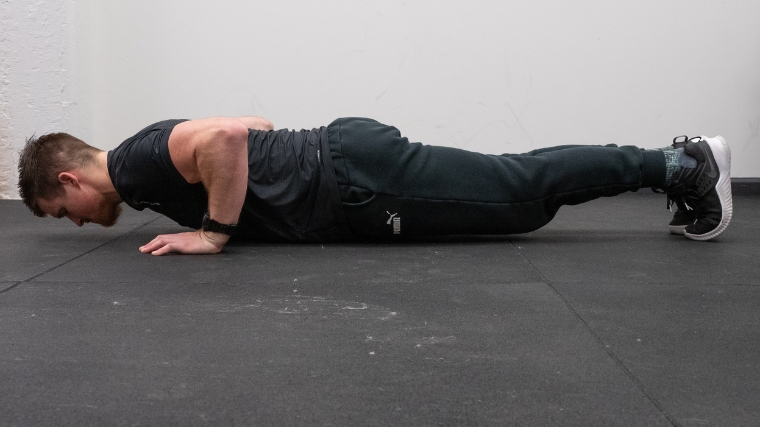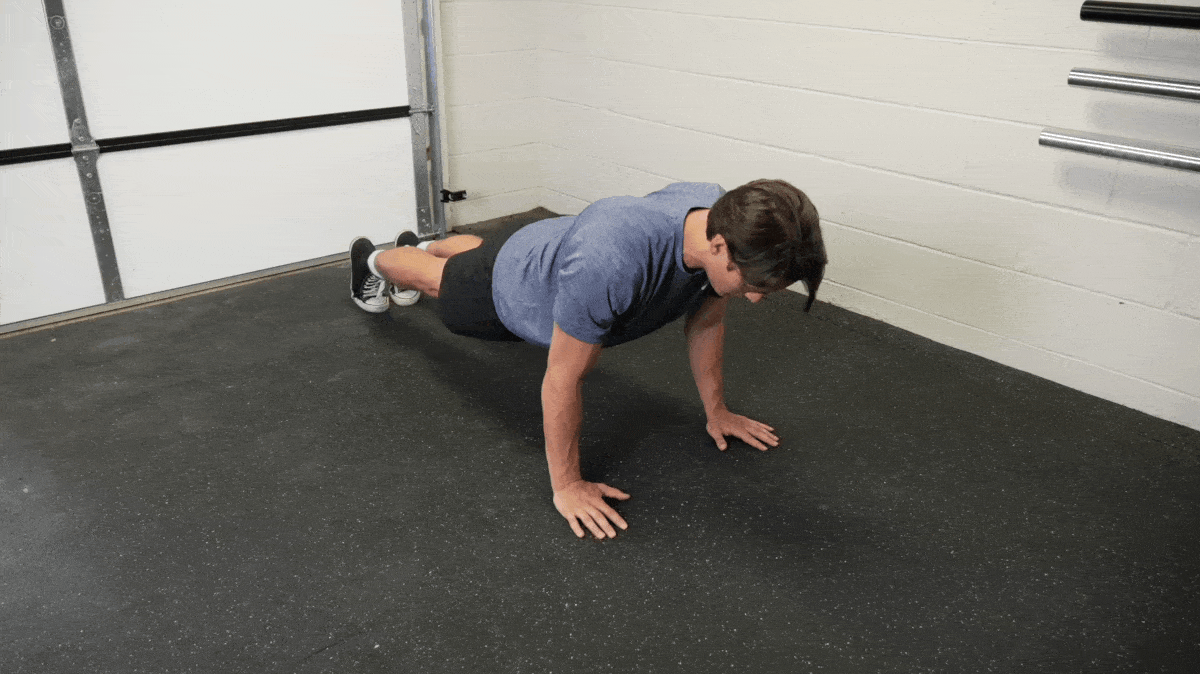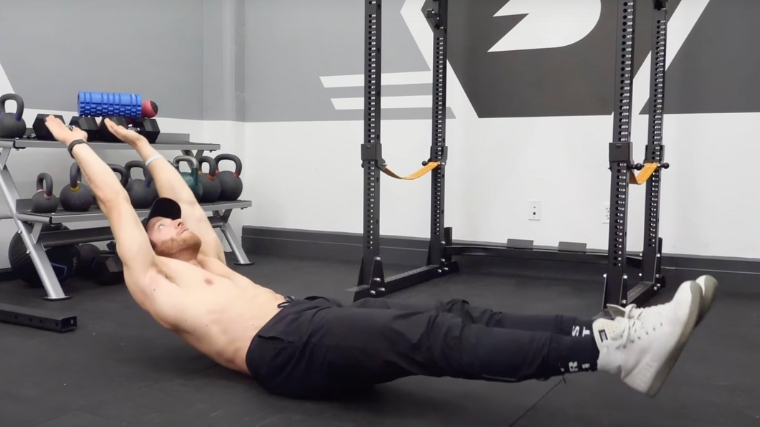If you’re a barbell devotee, you may be quick to dismiss quieter forms of exercise like walking, yoga, and Pilates. But that would be to the detriment of your routine. These low-impact forms of working out offer tremendous benefits — and we’ve chatted with a certified Pilates instructor to highlight the best parts of (you guessed it) Pilates workouts.
Believe it or not, Pilates exercises may just be the cheat code that makes your most demanding lifts both safer and easier. Aside from offering a strenuous core workout, Pilates is said to alleviate chronic lower back pain, improve posture, and upgrade overall stability. Even more convenient is how you can easily try out a Pilates workout plan at home.

Editor’s Note: The content on BarBend is meant to be informative in nature, but it should not be taken as medical advice. When starting a new training regimen and/or diet, it is always a good idea to consult with a trusted medical professional. We are not a medical resource. The opinions and articles on this site are not intended for use as diagnosis, prevention, and/or treatment of health problems. They are not substitutes for consulting a qualified medical professional.
What Is Pilates?
Pilates as we know it today is more about TikTok than world history. But the exercise method comes from an internment camp during World War I, established after the British government passed the “Aliens Restrictions Act” of 1914. This resulted in the interment of anyone the government deemed an “enemy alien.” Over 24,000 people were subsequently imprisoned at Knockaloe Camp, including Joseph Pilates. (1)(2)
Witnessing the physical deterioration of fellow prisoners and sparked by the metal coils attached to the headboards of hospital beds (think: modern-day Pilates reformers), Joseph Pilates engineered a form of exercise that was meant to strengthen the body and calm the mind, even during confinement, illness, and injury. (2)
[Read More: Mobility vs. Flexibility — Why It Matters and What It Means for You]
What does that involve? As originally conceived, Pilates is a collection of 34 mat-based movements. The original name of Pilates’ workout routine was called “Contrology,” and stemmed from the concept of achieving strength by maintaining total control over your body. All of the moves in the original Pilates playbook are bodyweight exercises intended to boost strength and flexibility. (3)
A quick but important note: “Pilates” has been legally deemed to be a generic term, so many workouts have been developed as derivatives of the original Pilates routine. As a result, several workout routines and styles claim to descend from Joseph Pilates’ original set of 34 movements. This is true whether they are mat-based Pilates and require no equipment, or use Pilates reformers and call for specialized equipment.
Try This 20-minute Pilates Workout
There are certainly endless variations of Pilates sessions to try, with many promising — and providing — a solid ab workout that even beginner Pilates enthusiasts can take on. From home workouts to 30-minute full-body Pilates sessions in the studio complete with reformers, there are Pilates options for so many people out there.
But to Pilates purists, there is only one Pilates workout.

[Read More: The Best Yoga Poses for Beginners to Support Bigger, Better Lifts]
The traditional 34-exercise mat Pilates routine was prescribed in a precise sequence. If you adhere to the original timeframe for completing the exercises, they are likely to take you an hour to complete. However, this is by no means a binding rule, as the benefits of Pilates can be achieved over shorter workouts.
The Workout
When you’re talking about the original version, the primary difference between a beginner-friendly Pilates workout and an intermediate Pilates routine is the number of exercises you can perform.
Some movements may require you to improve your strength and flexibility over several training sessions. Even if you can’t complete every move the first time, this is a full-body Pilates workout that will sculpt your muscles and make you feel good without adding stress to your lower back.
[Read More: The 10 Best Leg Stretches to Bolster Your Lower Body Training]
“Even if you’re only getting 10 to 20 minutes, you can run through the series and get a lot done and feel a lot better,” encourages Butcher. “It’s also okay to do fewer movements, like 25 of the 34. Many of the classes that I teach do not have all 34 movements in them. That’s something people have to build up to as opposed to being able to do it right off the bat.”
You can also customize the movements as needed. For example, with high scissors, there’s no need to brace your body weight on your hands. You can easily perform this move lying down as normal, doing slow, controlled lying scissor kicks with straight or even bent legs.
- The Hundred — Lift your legs with your back flat on the ground. Move your straight arms up and down (parallel to the ground), using your core to maintain stability.
- The Roll Up — With your legs extended and your arms straight out above you, roll up to a seat (like a straight-legged sit-up).
- The Roll-Over — Keeping your arms straight and stable by your sides, use your core to roll your lower back up and over your head. Keep your legs as straight as possible, aiming to touch your toes to the ground above your head.
- Single-Leg Circles — With one leg flat on the ground, create a circle above your hips with the other leg, kept as straight as you can.
- Rolling Like A Ball — Bend your knees and grab onto your lower shins or just above your ankles with your hands. Use your core to roll yourself up to a seat before rocking back.
- The Single-Leg Stretch — With your lower back pressed flat into the exercise mat, your shoulder blades slightly off the ground, and your legs straight and extended diagonally out in front of you. Keep one leg extended while hugging your opposite knee to your chest. Switch legs, maintaining core tension.
- The Double-Leg Stretch — Perform the hugging motion of the previous exercise, except with both legs at once.
- Spine Stretch Forward — With both legs straight and extended in front of you, bend forward at your waist, extending your arms over your legs to bring your chest toward your thighs.
- Open-Leg Rocker — Perform a movement similar to rolling like a ball, but with your legs straight and your hands braced on your ankles.
- Corkscrew — Do a similar move to the roll-over, but starting with your legs on one side of your body and rotating as you complete the movement (like a corkscrew).
- Saw — Sit up with your legs extended straight and your arms spread out like a T on either side. Rotate to the left with a straight spine and bring your right arm down to the outside of your left foot.
- Swan — Lie on your stomach on the mat with the backs of your feet on the mat. Place your hands under your shoulders and press slowly up until your upper peels away from the floor.
- Single-Leg Kicks — Brace your upper body weight on your forearms (without “dumping” all your weight there) and take turns bending your knees to kick toward your glutes with one foot at a time.
- Double-Leg Kicks — This time, lower your upper body to the floor and kick both legs toward your glutes at once. In between kicks, extend your arms behind your lower back and raise your upper body slightly off the mat.
- Neck-Pull — Sitting on your butt with your legs extended, clasp your hands behind your head. Curl all the way down toward your legs, then slowly lower down to the mat.
- High Scissors — Brace your lower back and glutes with your hands so that your upper body weight is balanced on your upper back and shoulders. Kick one extended leg down at a time, like a “scissor” motion.
- High Bicycle — Maintaining that upper body position, bend your knees and kick each leg in turn as though you were riding a bicycle.
- The Shoulder Bridge — Rise into a glute bridge with your arms braced so that your hands can support your lower back. Straighten one leg and bring it toward the ground, raise it all the way up, and back.
- Spine Twist — Perform a similar movement you did with the saw, seated with your legs out in front of you and your arms out like a T. Rotate with a straight back. Just don’t touch toward your toes like you would with the saw.
- Jack Knife — Do the same move as you did with the corkscrew, but simply go up and down with your straight legs. No need to move from side to side.
- Side Kicks — Lie on your side with your ears braced between your hands and your bottom leg straight out. Extend your top leg out into a swinging kick and bring it back with control.
- The Teaser — Lie on your back and bring your extended legs up to a V position relative to your torso. Extending your arms and leading with them (but primarily working from the core), come to a V position with your full body with your arms raised above your head.
- Hip Twist — Keep your legs in that V position and brace your upper body on your hands, extended with your hands resting on the mat behind you. With control, move your legs in a circular motion.
- Swimming — Lie on your stomach and extend all of your limbs. With straight elbows and knees, alternate raising your arms and legs upside down (yes, like you’re swimming).
- Leg Pull Down — Get into a push-up position. Press your heels away from the ground so that your body shifts up and forward (your weight into your arms and hands). Settle back and repeat.
- Leg Pull Up — Flip your position so that you’re in reverse tabletop, but with straight legs. Keeping your upper body stable, raise one straight leg all the way up, then back down. Alternate.
- Kneeling Side Kicks — Get on your side and brace your weight on the hand and knee of one side of your body. Brace your free hand on your head (like you were doing a classic sit-up) and straighten your free leg.
- Side Bend — Start in the same side position but with your leg so that it’s straight. Let your hips dip down to the mat, then extend so that your hips rise.
- Boomerang — Do a jack knife to bring your legs above your head. With control, come back to a V-sit, reaching toward your toes. Bring your arms behind you and brace as you let your straight legs come down to the mat in front of you. Bend at your waist to bring your chest close to your thighs.
- Seal — Thread your arms through your bent legs and grab the outsides of your ankles from the inside of your legs. Carefully rock back onto your shoulder blades, then back to a curled V position.
- Crab — Criss-cross your legs and grab your opposite feet with your opposite hands (so, your left hand grabs your right foot). Rock back onto your shoulder blades and carefully switch the position of your legs. Rock up to sit, continuing as far forward as you can without completely tipping forward.
- The Rocking — Lie on your stomach, bend your knees, and reach back to grab the tops of your feet with your hands. Rock back and forth while in this boat-like position.
- The Control Balance — Lift your legs to above your head (ideally with your toes resting on the ground above your head), with your weight carefully balanced on your upper back and shoulder blades. Hold your ankles. Let one ankle go as you raise the leg. Slowly lower, re-grab, and alternate legs.
- Push-Ups — Perform push-ups with your elbows kept close to your body.
[Read More: The Best Mobility Exercises From a Physical Therapist (+ Tips)]
Modifications
- Make it Easier: If you only have 20 minutes to spare for your Pilates workout, you have several options for shortening the routine’s duration. You can limit each exercise to 30 seconds in length, or conclude your workout at the 20th minute, no matter how many exercises you complete. It may also be advisable to skip or modify exercises in the sequence, as many moves are advanced.
- Make it Harder: A full Pilates workout will be tremendously challenging already, but you can extend the length of time you’re doing each exercise if desired. You can also make it subtly more difficult by working to increase the range of motion in each of the exercises when you can.
The Benefits of Pilates
Bodies that have been built by Pilates are often known to be strong, firm, and flexible. (4) These attributes are advantageous to anyone interested in maximizing their health and vitality. Moreover, you’re also getting all of this at a low cost to your joints.
Core Connection
If you lift heavy weights, you know the importance of developing a strong midsection. Conversely, you also recognize how quickly a lift can break down if your core isn’t adequately involved in the lift, or if your large muscle groups have to compensate for a lack of core strength. Even at-home Pilates workouts will help you reestablish the connection of your core to the rest of your body.

[Read More: The Stretches That Can Help Your Posture]
“When you lift weights, sometimes you’re being so forceful that your big muscles like your quads, back, and butt start to take over and do all the work,” cautions Butcher. “Then your connecting muscles — even your abdominals — don’t engage as they should. Pilates is a low-impact way to build your core connection and teach your body what to do when you encounter a heavy weight. You’ll intuitively start to make those corrections without having to overload your body.”
Increased Stability
One of the benefits often attributed to Pilates is its ability to help you increase your stability starting with your center, and then progressively extend that stability outward through your limbs. With your back and abdominals properly strengthened and balanced through Pilates, Butcher says your core will become a more stable anchor point for all of your lifts.
[Read More: What’s the Difference Between Passive and Active Stretching?]
“With Pilates, we hold the center strong and then reach out and away to start opening up and building the strength of everything else,” Butche explains. “We don’t individualize arms and legs; we use them as part of the whole. Pilates will help everything become stronger, safer, and more stable.”
Boosted Flexibility
Pilates is strongly linked to improvements in flexibility amongst people who repeat these movements week after week. (5) No, Pilates isn’t as simple as basic stretching, or quite as intent on using your breath to drive limb lengthening as yoga. Instead, Butcher attributes Pilates’ tendency to improve your flexibility to its ability to place your body into a long and strong configuration.
[Read More: Why Yoga Is Necessary For Strength Athletes]
“Flexibility comes from stability,” asserts Butcher. “If you’re stretching your hamstring and your back is round and your pelvis is collapsed backward into that posterior tilt, you’re not really stretching your hamstring. Flexibility increases as soon as you start to learn how to stabilize your pelvis and organize your body during those postures. You need to have a stable core before those stretches start to do anything real.”
FAQs
If you still have questions about whether or not Pilates is the missing ingredient in your workout routine, we’ve supplied answers to some of those questions below.
What kind of workout is Pilates?
At its essence, Pilates is a calisthenic training (bodyweight) workout that prioritizes core strength and flexibility. (6)
Is 20 minutes of Pilates a day enough?
Although Pilates was conceived by its founder as an hour-long movement series, 20 minutes of Pilates training is generally sufficient to achieve several of Pilates’ benefits.
What is Pilates training?
Pilates training involves taking the body through a series of core-strengthening movements that are intended to improve posture, balance, strength, and flexibility. (3)
What are the benefits of doing Pilates regularly?
The benefits of performing Pilates regularly include an engaged core, heightened stability, and improved flexibility. (3)
References
- “The Start of WWI Internment.” Knockaloe.im. Retrieved from: https://www.knockaloe.im/page_346204.html
- Olorunshola, Yosola. (2021) “The Exercise Phenomenon Born in a Prisoner-of-War Camp.” National Geographic UK.
- Kloubec J. Pilates: how does it work and who needs it? Muscles Ligaments Tendons J. 2011 Dec 29;1(2):61-6.
- Emery K, De Serres SJ, McMillan A, Côté JN. The effects of a Pilates training program on arm-trunk posture and movement. Clin Biomech (Bristol, Avon). 2010 Feb;25(2):124-30.
- Desai R, thakrar G, Shukla H. Effects of pilates exercises on trunk strength, endurance and flexibility in computer professionals. Int J Health Sci Res. 2020; 10(12):80-85.
- Emery K, De Serres SJ, McMillan A, Côté JN. The effects of a Pilates training program on arm-trunk posture and movement. Clin Biomech (Bristol, Avon). 2010 Feb;25(2):124-30.
The post Is Pilates the Key to Strength Training Stability? Here’s the Classic Pilates Workout, Explained by an Instructor appeared first on BarBend.

